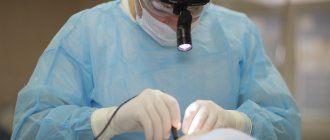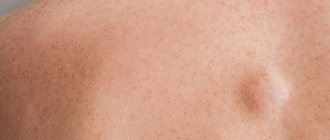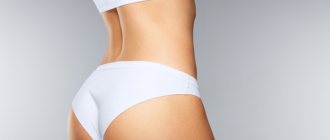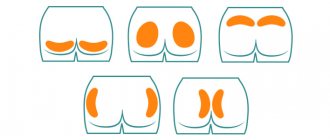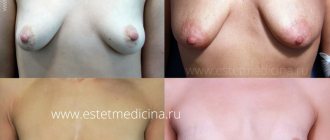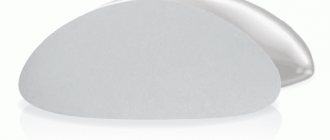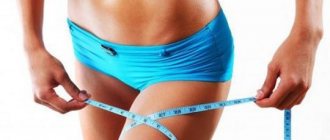Methods for correction of the buttocks Contraindications Preparation for surgery How gluteoplasty is performed Rehabilitation
Gluteoplasty (correction of the buttocks) is relevant for: drooping buttocks, small buttocks, atrophy or deformation of soft tissues, consequences of injuries. After the operation, the buttocks acquire a harmonious shape, a raised and rounded shape.
To decide on the modeling method, you need to know the beauty standards that relate to the buttocks:
- The volume is distributed evenly. That is, if you visually “draw” horizontal and vertical lines in the middle of the buttocks, then the four squares should be approximately the same.
- The V-zone is well defined. The shape of the buttocks is determined by the gluteus maximus muscle, which is about 80% of the area. Starting from the coccyx and the back of the ilium, the muscle goes, curving, and connects with the paired large muscle. This is how the V-zone is formed. The larger the recess, the more aesthetically pleasing it is.
- The “diamond-shaped space” looks aesthetically pleasing. This zone is also formed by the gluteus maximus muscle. Its inner edge goes down and out, forming a fold. This fold should divide the muscle into 2/3 of its length, continuing at an angle of 45 degrees with respect to the thigh. Together with the fold on the opposite side, it forms a diamond. This is the “diamond-shaped space”.
What is gluteoplasty?
Gluteoplasty or buttock replacement is a surgical operation to install implants under the gluteal muscle or its fascia. They are a dense shell with a smooth or ribbed surface, filled with viscous silicone (volume 140-180 ml).
Gluteal implants can be round or oval (used to give the “fifth point” roundness), teardrop-shaped (to correct those resulting from injuries, surgeries or congenital defects).
Gluteal endoprostheses differ from breast implants in their increased strength, and if they are damaged, silicone does not migrate into the surrounding tissues.
Femoroplasty - hip plastic surgery with implants
What part of the body do you think most often attracts attention and is discussed?
Oddly enough, these are legs, and not only women’s ones. The slenderness of your legs can be emphasized by a short skirt and high heels, which exist outside of fashion and time.
For a long time, curvature of the legs was entangled in many myths and speculations and was considered an irreparable defect. People suffering from a defect of the lower extremities made attempts to solve the problem with the help of physical exercises, to hide the imperfection of the figure under clothes, but they did not always achieve the effect.
Fortunately, today I can offer my patients an excellent technique for correcting the shape of the hips and increasing them using implants - femoroplasty.
Technique of the operation
The technique of the operation can be divided into three main stages:
- After the onset of anesthesia, an incision of the intergluteal fold, 3 to 5 cm long, is made in the sacral area.
- At the site of the incision, a bed for the endoprosthesis is formed (under the gluteus maximus muscle, its fascia, or inside the muscle). The implant is not placed directly under the skin, since with such an installation there is a high probability of the formation of an overly thick capsule around it, which in the future threatens to compress the prosthesis and deform the buttocks.
- The surgeon sutures the incision site with self-absorbing sutures.
The intervention lasts from 1.5 to 3 hours, and after it you need to spend another 2-3 days in the hospital.
Prices for services
| Price | On credit* | |
| Gluteoplasty - buttock augmentation using an implant | 150,000 rub. | from RUB 14,990/month |
| Consultation with a plastic surgeon for surgery | 0 rub. | — |
Average cost of services
You can find out how much our plastic surgery services cost on average by calling in St. Petersburg: +7
SM-Clinic surgeons will develop an individual operation plan for you, since surgical body correction is often planned and carried out in a complex manner. The exact cost is calculated individually after consultation with a doctor.
Plastic surgery on credit and in installments
Possible consequences
Immediately after gluteoplasty, the following consequences may occur:
- seromas;
- bleeding;
- severe pain;
- swelling, hematomas;
- elevated temperature;
- temporary decrease in sensitivity in the operated tissues;
- difficulty gait due to pinched sciatic nerve;
- suppuration, fistula.
In the future, possible consequences such as:
- asymmetry of the buttocks due to displacement of the endoprosthesis;
- increased scarring of the skin;
- suture divergence (most often due to non-compliance with the surgeon’s recommendations);
- palpation or visual identification of implants under the skin.
One of the significant postoperative consequences is that injections after endoprosthetics can only be given in the thigh, which is not always possible to inform a health care provider (for example, after a car accident or a fall from a height).
See also: Buttock augmentation with hyaluronic acid
Buttock correction methods
Augmentation with implants
Silicone implants are used to correct the buttocks in modern plastic surgery. The cost of buttock augmentation depends on the chosen method and type of implant. After restoration, they are completely invisible and cannot be felt when walking. Dentures come in two forms:
- round;
- pear-shaped (anatomical shape).
- The type and size of the prosthesis is selected by the surgeon during the examination depending on the anatomical features of the patient.
Implants can be porous or smooth and come in different sizes. Smooth texture is more durable, there is no risk of deformation over time. Endoprostheses also differ in material. It is believed that silicone products are the most durable and are similar in structure to the structure of muscles. However, those filled with saline solution are safer because they will not cause harm if they rupture. The type and size of the prosthesis is selected by the surgeon during the examination depending on the anatomical features of the patient. The selection process is based on anatomy and general health. If there is a deficiency of fat, it is not recommended to perform buttock surgery with implants that are too large. This can disrupt the proportions of the body, and the boundaries of the transition from the endoprosthesis to one’s own tissues may be noticeable.
Implants are made of very durable material that can withstand significant loads - sports, household loads, sedentary work, etc. Manufacturers give a lifetime warranty on implants and unlimited periods of use.
Lipofilling – buttock augmentation with your own fat
This method is considered the safest and most physiological. Plus, it allows you to adjust two zones at once. To enlarge your buttocks, your own fat is taken from the abdomen, back, thighs or other part of the body. Next, it is centrifuged, purified and injected into the problem area. Fat tends to dissolve at first, so the surgeon injects a little more than necessary to achieve the desired result. The operation is performed under general anesthesia and lasts about an hour. The advantage of lipofilling is that autologous fat does not cause allergies and is not rejected. If all recommendations are followed, the result can last for life or at least 10-15 years.
Thread lifting
The procedure involves the implantation of special medical threads under the skin, which tighten the muscles, thereby significantly improving the shape of the buttocks. This technique is called “filament lifting”. The effect of the operation is noticeable almost immediately, but is fully manifested a few weeks after the swelling has subsided. The achieved result lasts for 2-3 years. This is a good alternative to plastic surgery; even famous women have experienced it. However, this type of lift is not suitable for everyone. The degree of sagging of tissues is divided into two types:
- preptosis is a not very deep skin fold between the thigh and buttock, which can be corrected with thread lifting;
- ptosis - a deep, noticeable fold, the tissue hangs over the thigh - surgical correction is indicated.
Introduction of hyaluronic acid
Hyaluronic acid moisturizes, rejuvenates, and removes wrinkles. By introducing fillers based on it, asymmetry can be removed and volume restored. Hyaluronic acid will help restore the shape of the buttocks after sudden weight loss and remove age-related imperfections. At the same time, the production of your own elastin and collagen is activated, which improves the result. Fillers are injected with thin needles; this is not an operation, so general anesthesia and long preparation are not required. The effect is visible immediately and lasts for about 3-4 years, after which about 60% of the result remains. Fillers smooth out contours, correct imperfections, and remove the consequences of unprofessional installation of implants.
Surgical lifting
This is an operation aimed at moving skin-fat flaps and, if necessary, excision of excess tissue. As a result, the contours are improved, the gluteal area is raised, and folds disappear. The incisions are made in the subgluteal fold, so the scars will be almost invisible. The operation is indicated for severe ptosis and the patient is simply dissatisfied with the appearance of the gluteal area.
Possible complications
Complications of lifting the inner thigh are rare, because at this stage of development of plastic surgery, doctors are doing everything to prevent any negative consequences. They usually develop due to individual rare characteristics of the body, or improper postoperative care. In the hospital, careful prevention of complications is mandatory. These include:
- the formation of keloid scars due to genetically determined factors;
- suppuration of the wound due to improper treatment;
- necrosis (death) of the skin along the edges of the wound;
- seromas and hematomas are accumulations of fluid and blood, which in most cases resolve on their own;
- asymmetry of the genital organs or limbs in volume (extremely rare);
- violation of venous outflow;
- persistent swelling due to inhibition of lymphatic drainage;
- thrombosis and thrombophlebitis.
Types of implants
The result of plastic surgery depends largely on the type of endoprosthesis. They are made from durable materials that can withstand the weight of a person, and filled with silicone. By
According to their shape, implants are divided into:
- Anatomical, which give the buttocks the most natural look. But they can significantly change the shape of this part of the body, and not just increase volume.
- Round, allowing you to significantly enlarge the buttocks. Their use is preferable when there is really a need for it. Otherwise, the buttocks will look “pumped.”
According to the surface texture, implants can be smooth or rough. The former are considered more suitable for gluteoplasty; they cause fewer complications. But rough ones are held more firmly in tissues.
Non-surgical liposuction
In recent years, this technique has won the trust of hundreds of patients due to the fact that it is the least traumatic and difficult for the body of all existing ones. It does not require general anesthesia and leaves no marks on the skin. However, it also has disadvantages.
For a noticeable effect, you need to undergo at least 6-8 procedures with an interval of a week to two. As a result, you will have to wait a long time for the desired result.
During non-surgical liposuction, under the influence of a device that the doctor passes over the surface of the skin, fat cells are broken down and turned into shapeless fat. It enters the intercellular space and from there into the blood and lymph. Then this emulsion is naturally eliminated from the body on its own. Most of it initially ends up in the lymph, so non-surgical liposuction is often combined with lymphatic drainage procedures that help eliminate stagnation of lymph flow.
Devices for such liposuction use ultrasound or laser. Also considered non-surgical is the water jet method, in which fat cells are broken down and washed out with a special solution.
Contraindications
The before and after effect of buttock implants reveals a significant difference in size and overall appearance. But it is available only to those who have no contraindications:
- cardiovascular diseases;
- oncology;
- diseases of the endocrine system;
- infections, including common colds;
- problems affecting blood clotting;
- pregnancy, lactation and menstrual periods.
We recommend reading about lipofilling of the buttocks. From it you will learn about the features of the procedure, its advantages, and the rehabilitation period. And here is more information about the various methods of buttock surgery.
Plastic surgeons at the clinic
Yakimov Dmitry Konstantinovich
Experience - 38 years
Doctor of the highest category. Candidate of Medical Sciences. Member of the Society of Plastic Surgeons. Author of more than 30 works in the field of surgery, teacher at the Military Medical Academy.
Gvaramiya Eka Yurievna
Experience - 17 years
Participant of congresses, conferences and seminars on plastic surgery. Priority areas: mammoplasty (breast plastic), blepharoplasty, tummy tuck (abdominoplasty), liposuction, lipofilling, face lift, lip plastic, ear plastic, intimate plastic, body plastic, reconstructive plastic, solving aesthetic problems.
Classic liposuction
This type of femoroplasty is aimed exclusively at removing excess subcutaneous fat. It is suitable for obese patients, both women and men, as well as anyone who has disproportionately wide hips due to fat.
The method involves making incisions about 1-2 cm in size at several points on the upper thigh. A metal tube, called a cannula, is then inserted into the tissue through these incisions. It is used to separate fat from the skin and then pump it out with a special device. Through the tube, fat is removed from the body and the vacated space is filled with saline solution in the same amount. Finally, the holes are sutured with invisible sutures.
Preparing to Change Forms
The approach to surgery consists of examining the patient. He takes blood and urine tests, for coagulation, for infections, does an ECG and fluorography, as well as an ultrasound of the pelvis (women). At this stage, the size and shape of the implants and the location of their installation are determined.
Then the patient himself does the preparation. He should quit smoking and stop drinking alcohol 2 weeks before the intervention. Taking medications that affect blood clotting should also be completed. You should eat well, but without excess, and stop visiting the solarium for half a month. The last meal before gluteoplasty should be 8 - 10 hours. The final preparatory action is the application of markings on the patient’s skin by the doctor immediately before the operation.
Benefits of the procedure
Correction of the buttocks using implants has a number of advantages:
- gives a pronounced result for any initial parameters of the problem area;
- the effect lasts for a long time;
- with a high-quality operation and proper preparation, the risk of complications is low;
- the result is visible almost immediately;
- the operated area of the body does not lose its natural appearance;
- traces of the intervention after healing are invisible.
Rehabilitation period
Rehabilitation for femoroplasty lasts from two to six months. The duration depends on the type of plastic surgery, the age of the person, the general condition and regenerative abilities of the body.
During the first one and a half to two weeks, swelling and bruising will persist in the correction areas. This is completely safe, they will soon disappear on their own. Pain at the beginning of the recovery period can be easily relieved with painkillers prescribed by your doctor.
Be sure to wear compression garments for a month. It is a shorts made of breathable, stretchy material. They are removed only during hygiene procedures. During rehabilitation you should not:
- exercise;
- visit solariums and sunbathe;
- take a steam bath and sauna;
- swim in pools and open water;
- apply creams to unhealed wounds.
